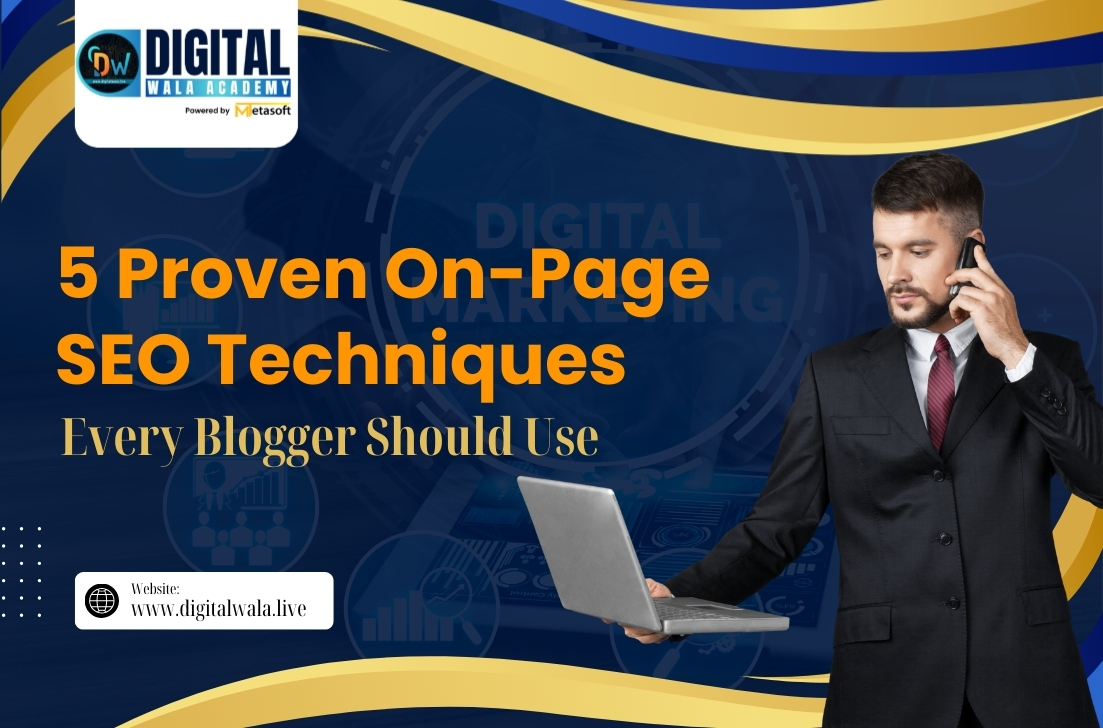5 Proven On-Page SEO Techniques Every Blogger Should Use – Digital Wala AI Academy
In today’s competitive digital landscape, mastering on-page SEO techniques is crucial for every blogger looking to increase organic traffic and improve search rankings. Whether you’re a content creator, business owner, or aspiring digital marketer in Dehradun, implementing these proven strategies will help you create content that both search engines and readers love.
At Digital Wala AI Academy, we’ve seen firsthand how proper on-page SEO implementation can transform a blog from obscurity to prominence. As the best digital marketing institute in Dehradun, we understand the local market dynamics and what it takes to achieve sustainable online growth through effective SEO practices.

Why On-Page SEO Matters More Than Ever in 2025
On-page SEO in 2025 has evolved beyond basic keyword stuffing and generic meta tags. Modern search engines prioritize user experience, content relevance, and technical precision. Google’s algorithm now focuses on understanding context and user intent rather than just matching keywords. This shift means bloggers must adopt a more sophisticated approach to content optimization.
The foundation of successful on-page SEO lies in balancing technical elements with creative content that genuinely serves your audience. Search engines like Google use over 200 ranking factors, with on-page elements playing a crucial role in determining how your content performs in search results.
Technique 1: Master Strategic Keyword Placement and Optimization
The Art of Natural Keyword Integration
Gone are the days when you could simply stuff keywords throughout your content. In 2025, strategic keyword placement focuses on natural integration that enhances readability while signaling relevance to search engines.
Key areas for keyword placement include:
-
Title tag (front-load your primary keyword)
-
First 100 words of your content
-
H1 and H2 headings (use variations and related terms)
-
URL structure (keep it short and keyword-rich)
-
Meta description (naturally incorporate primary keywords)
The most effective approach involves using 1-2 long-tail keywords per blog post. This focused strategy prevents keyword cannibalization and allows you to create more targeted, valuable content for your readers.
Advanced Keyword Strategy for Local Businesses
For businesses in Dehradun looking to improve their online presence, incorporating local keywords naturally throughout your content can significantly boost visibility. Terms like “best digital marketing academy in Dehradun” should be woven into your content where they add genuine value to the reader’s experience.
Technique 2: Optimize Meta Descriptions for Maximum Click-Through Rates
Crafting Compelling Meta Descriptions
Meta descriptions don’t directly impact rankings, but they significantly influence click-through rates (CTR), which indirectly affects your SEO performance. A well-crafted meta description acts as your content’s elevator pitch in search results.
Best practices for meta description optimization:
-
Keep it concise: 150-160 characters for optimal display
-
Include primary keywords early: Place important keywords at the beginning
-
Use action-oriented language: Start with compelling action words like “discover,” “learn,” or “master”
-
Match user intent: Ensure your description aligns with what searchers expect
-
Include a subtle call-to-action: Guide users toward clicking with phrases like “Start optimizing today”
With AI becoming more sophisticated, search engines are increasingly rewriting meta descriptions dynamically to match user queries. However, providing a well-optimized meta description still gives you control over how your content appears in search results.
Technique 3: Leverage Internal Linking for Content Authority
Building Topic Clusters Through Strategic Internal Linking
Internal linking is one of the most underrated SEO tactics that can boost performance with minimal effort. By connecting related content on your website, you create topic clusters that demonstrate expertise and help search engines understand your content’s context.
Effective internal linking strategies include:
-
Link to relevant content: Connect articles that share topical relationships
-
Use descriptive anchor text: Choose phrases that clearly describe the linked content
-
Pass authority to important pages: Link from high-performing pages to newer or priority content
-
Maintain contextual relevance: Ensure all internal links add value to the reader’s journey
The hub and spoke model works particularly well for educational content. Create comprehensive pillar pages around broad topics, then link to more specific articles that dive deeper into subtopics.
Internal Linking for Digital Marketing Content
When creating content about digital marketing or SEO, internal linking becomes especially powerful. For instance, a comprehensive guide about “digital marketing strategies” can link to specific articles about “social media marketing,” “content optimization,” and “local SEO tactics,” creating a robust knowledge base that keeps readers engaged.
Technique 4: Optimize Content Structure with Header Tags
Creating SEO-Friendly Content Hierarchy
Header tags (H1-H6) serve dual purposes: they improve readability for users and help search engines understand your content structure. Google has explicitly stated that using proper heading tags “helps Google understand the structure of the page”.
Header tag optimization best practices:
-
Use one H1 tag per page: Include your primary keyword in the H1
-
Create logical hierarchy: Use H2 for main sections, H3 for subsections
-
Include keyword variations: Incorporate related terms in subheadings naturally
-
Keep headers descriptive: Make them informative and engaging for readers
-
Maintain consistent formatting: Use headers to break up long content sections
Well-structured headers not only improve your SEO but also enhance user experience by making your content scannable and easier to digest.
Technique 5: Enhance Visual Content and Technical Elements
Optimizing Images and Visual Assets
Visual content is becoming increasingly important for on-page SEO in 2025. Images, videos, and infographics not only engage users but also provide additional optimization opportunities.
Image SEO best practices:
-
Use descriptive file names: Include relevant keywords in image file names
-
Optimize alt text: Provide clear, keyword-rich descriptions for accessibility
-
Compress file sizes: Ensure fast loading times with optimized image formats like WebP
-
Add schema markup: Use structured data to help search engines understand your visual content
Technical SEO Fundamentals
While creative content captures attention, technical SEO elements ensure your pages are discoverable and indexable:
-
HTTPS security: Ensure your website uses secure protocols
-
XML sitemaps: Help search engines crawl your content efficiently
-
Canonical tags: Prevent duplicate content issues
-
Core Web Vitals: Optimize for loading speed, interactivity, and visual stability
These technical elements might seem boring, but they’re essential for maintaining a healthy website that search engines can easily crawl and index.
Measuring Success: Tracking Your On-Page SEO Performance
Key Metrics to Monitor
Implementing these techniques is only the beginning. Regularly monitoring your performance helps you understand what’s working and where you need to improve:
-
Organic traffic growth: Track increases in search engine referrals
-
Keyword rankings: Monitor positions for target keywords
-
Click-through rates: Measure how compelling your titles and meta descriptions are
-
Bounce rates: Assess whether your content meets user expectations
-
Time on page: Evaluate content engagement and relevance
Use tools like Google Search Console, Google Analytics, and specialized SEO platforms to track these metrics consistently.
Frequently Asked Questions
How long does it take to see results from on-page SEO?
On-page SEO improvements typically show initial results within 2-4 weeks, with more significant improvements visible after 3-6 months of consistent implementation. The timeline depends on your website’s current authority, competition level, and the quality of your optimization efforts.
Should I optimize every blog post for SEO?
Yes, every blog post should follow basic on-page SEO principles. However, focus your most intensive optimization efforts on content targeting competitive keywords or serving important business objectives. Consistency in applying SEO best practices across all content creates a stronger overall foundation.
Can I over-optimize my content for search engines?
Over-optimization occurs when you prioritize search engines over user experience. Avoid keyword stuffing, excessive internal linking, or creating content that feels unnatural. The best digital marketing academy in Dehradun principles emphasize creating content that serves users first while incorporating SEO elements naturally.
How do I balance local SEO with broader keyword targeting?
For businesses in Dehradun, incorporate local keywords naturally within broader content strategies. Create location-specific pages for services while maintaining topically relevant blog content that can attract both local and broader audiences.
What’s the most important on-page SEO factor for bloggers?
Content quality remains the most crucial factor. Search engines prioritize content that thoroughly addresses user intent and provides genuine value. Technical optimization supports great content but cannot compensate for poor or irrelevant material.
Conclusion: Your Path to SEO Success
Implementing these five proven on-page SEO techniques will significantly improve your blog’s search performance and user engagement. Remember that SEO is not about manipulating search engines but about creating the best possible experience for your readers while making your content easily discoverable.
The digital marketing landscape continues to evolve, and staying updated with the latest techniques is crucial for long-term success. At Digital Wala AI Academy, we’re committed to helping bloggers, entrepreneurs, and businesses in Dehradun master these essential skills.
Ready to transform your blog’s performance and dominate search results? Join the hundreds of successful digital marketers who have advanced their careers through our comprehensive SEO training programs. Our expert instructors provide hands-on guidance, real-world case studies, and the latest industry insights to help you achieve sustainable online growth.
Contact Digital Wala AI Academy today and discover how our proven SEO strategies can elevate your content, increase your organic traffic, and establish your authority in the competitive digital landscape. Whether you’re a beginner looking to learn the fundamentals or an experienced marketer seeking advanced techniques, our customized training programs will accelerate your success in the world of search engine optimization.
